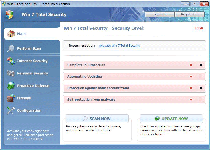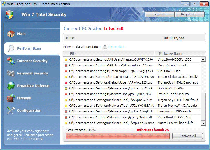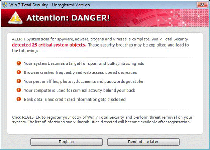Win 7 Total Security 2013
Posted: October 25, 2012
Threat Metric
The following fields listed on the Threat Meter containing a specific value, are explained in detail below:
Threat Level: The threat level scale goes from 1 to 10 where 10 is the highest level of severity and 1 is the lowest level of severity. Each specific level is relative to the threat's consistent assessed behaviors collected from SpyHunter's risk assessment model.
Detection Count: The collective number of confirmed and suspected cases of a particular malware threat. The detection count is calculated from infected PCs retrieved from diagnostic and scan log reports generated by SpyHunter.
Volume Count: Similar to the detection count, the Volume Count is specifically based on the number of confirmed and suspected threats infecting systems on a daily basis. High volume counts usually represent a popular threat but may or may not have infected a large number of systems. High detection count threats could lay dormant and have a low volume count. Criteria for Volume Count is relative to a daily detection count.
Trend Path: The Trend Path, utilizing an up arrow, down arrow or equal symbol, represents the level of recent movement of a particular threat. Up arrows represent an increase, down arrows represent a decline and the equal symbol represent no change to a threat's recent movement.
% Impact (Last 7 Days): This demonstrates a 7-day period change in the frequency of a malware threat infecting PCs. The percentage impact correlates directly to the current Trend Path to determine a rise or decline in the percentage.
| Threat Level: | 1/10 |
|---|---|
| Infected PCs: | 9 |
| First Seen: | October 25, 2012 |
|---|---|
| Last Seen: | June 18, 2023 |
| OS(es) Affected: | Windows |
 As one of many members of the gang of fake anti-malware scanners known by the title of FakeRean, Win 7 Total Security 2013 pretends to protect your computer but actually is involved in attacks that hijack your web browser, block programs without just cause, delete crucial system components and changes your security settings in negative ways. Win 7 Total Security 2013's disguise for these attacks is to play at being an anti-malware product, although SpywareRemove.com malware researchers haven't found evidence of Win 7 Total Security 2013 ever displaying accurate or legitimate system alerts of any type. The safest solution to a Win 7 Total Security 2013 problem is to use real anti-malware software to delete Win 7 Total Security 2013, and, while Win 7 Total Security 2013 is active, you should take any steps that are necessary to access such software.
As one of many members of the gang of fake anti-malware scanners known by the title of FakeRean, Win 7 Total Security 2013 pretends to protect your computer but actually is involved in attacks that hijack your web browser, block programs without just cause, delete crucial system components and changes your security settings in negative ways. Win 7 Total Security 2013's disguise for these attacks is to play at being an anti-malware product, although SpywareRemove.com malware researchers haven't found evidence of Win 7 Total Security 2013 ever displaying accurate or legitimate system alerts of any type. The safest solution to a Win 7 Total Security 2013 problem is to use real anti-malware software to delete Win 7 Total Security 2013, and, while Win 7 Total Security 2013 is active, you should take any steps that are necessary to access such software.
Win 7 Total Security 2013 and the Total Danger Package – Complete with 'Security' Wrapping on Top
Win 7 Total Security 2013 is designed primarily for the task of convincing you of two things: that your computer is infected by a teeming host of malware and that you need to buy Win 7 Total Security 2013 as the solution to this supposed problem. To enable this deception, Win 7 Total Security 2013 displays pop-ups such as Taskbar balloons, dialog boxes reminiscent of Windows alerts and even fake error screens from within your web browser. In doing so, Win 7 Total Security 2013 also blocks other programs and various websites, particularly those applications or sites that are related to PC security and anti-malware solutions.
However, SpywareRemove.com malware researchers are comfortable in labeling Win 7 Total Security 2013 a fraud that's not capable of detecting actual infections or other security problems, not least because Win 7 Total Security 2013's interface is clearly copied from other scamware products from the FakeRean family. Purchasing Win 7 Total Security 2013 should never be used as a solution to Win 7 Total Security 2013-related problems, and system alerts that appear while Win 7 Total Security 2013 is open should always be considered suspect by default.
Spam e-mail, social networking sites and P2P-distributed files all have been found to be viable infection vectors for Win 7 Total Security 2013 and its relatives such as Antivirus 2008 Pro, Windows Antivirus 2008, Vista Antivirus 2008, Antivirus XP 2008, PC Clean Pro, Antivirus Pro 2009, AntiSpy Safeguard, ThinkPoint, Spyware Protection 2010, Internet Antivirus 2011, Palladium Pro, XP Anti-Virus 2011, CleanThis, Rogue.Vista Antivirus 2008, XP Home Security 2012, XP Security 2012 and AntiVirus PRO 2015. SpywareRemove.com malware experts recommend avoiding suspicious links, sites and download sources to cut off the majority of likely ways for Win 7 Total Security 2013 to infect your PC.
Peeling All the Layers of What Win 7 Total Security 2013 Afflicts on Your PC
Besides the many issues noted earlier, Win 7 Total Security 2013 may also cause significant system changes that are typical to members of its branch of FakeRean. These changes can cause security issues for your PC, in addition to making it difficult to remove Win 7 Total Security 2013 without a qualified anti-malware program. SpywareRemove.com malware researchers have taken note of the following attacks, in particular:
- Win 7 Total Security 2013 makes Registry changes that allow its software to launch whenever Windows starts, as well as when any other program is launched (the latter is used by Win 7 Total Security 2013 as a program-blocking mechanism).
- Web traffic for popular web browsers will be monitored by Win 7 Total Security 2013. Sites that Win 7 Total Security 2013 prefers that you don't access (such as PC security domains) will be blocked, and you may be redirected to fake error pages.
- Windows Update and default Windows security tools may be deleted by Win 7 Total Security 2013. Your firewall also may be disabled.
Despite the many attacks that Win 7 Total Security 2013 brings to bear, Win 7 Total Security 2013 can be disabled through Safe Mode or other methods of booting your OS safely. A disabled Win 7 Total Security 2013 can be deleted, along with its system changes, by any competent anti-malware application, which SpywareRemove.com malware analysts recommend doing ASAP.


Use SpyHunter to Detect and Remove PC Threats
If you are concerned that malware or PC threats similar to Win 7 Total Security 2013 may have infected your computer, we recommend you start an in-depth system scan with SpyHunter. SpyHunter is an advanced malware protection and remediation application that offers subscribers a comprehensive method for protecting PCs from malware, in addition to providing one-on-one technical support service.
* See Free Trial offer below. EULA and Privacy/Cookie Policy.
Why can't I open any program including SpyHunter? You may have a malware file running in memory that kills any programs that you try to launch on your PC. Tip: Download SpyHunter from a clean computer, copy it to a USB thumb drive, DVD or CD, then install it on the infected PC and run SpyHunter's malware scanner.
Technical Details
File System Modifications
Tutorials: If you wish to learn how to remove malware components manually, you can read the tutorials on how to find malware, kill unwanted processes, remove malicious DLLs and delete other harmful files. Always be sure to back up your PC before making any changes.
The following files were created in the system:%AppData%\[RANDOM 3 LETTERS].exe
File name: %AppData%\[RANDOM 3 LETTERS].exeFile type: Executable File
Mime Type: unknown/exe
Group: Malware file
Additional Information
| # | Message |
|---|---|
| 1 | System danger!
Your system security is in danger. Privacy threats detected. Spyware, keyloggers or Trojans may be working in the background right now. Perform an in-depth scan and removal now, click here. |
| 2 | Virus intrusion!
Your computer security is at risk. Spyware, worms and Trojans were detected in the background. Prevent data corruption and credit card information theft. Safeguard your system and perform a free security scan now. |
| 3 | Win 7 Total Security 2013 Firewall Alert
Win 7 Total Security 2013 has blocked a program from accessing the internet Internet Explorer is infected with Trojan-BNK.Win32.Keylogger.gen Private data can be stolen by third parties, including credit card details and passwords. |
Leave a Reply
Please note that we are not able to assist with billing and support issues regarding SpyHunter or other products. If you're having issues with SpyHunter, please get in touch with SpyHunter customer support through your SpyHunter . If you have SpyHunter billing questions, we recommend you check the Billing FAQ. For general suggestions or feedback, contact us.